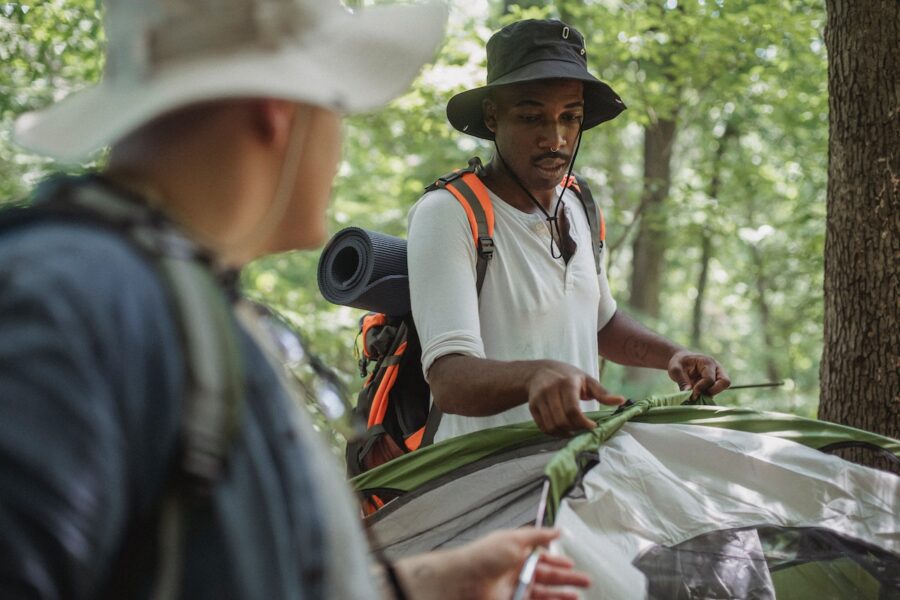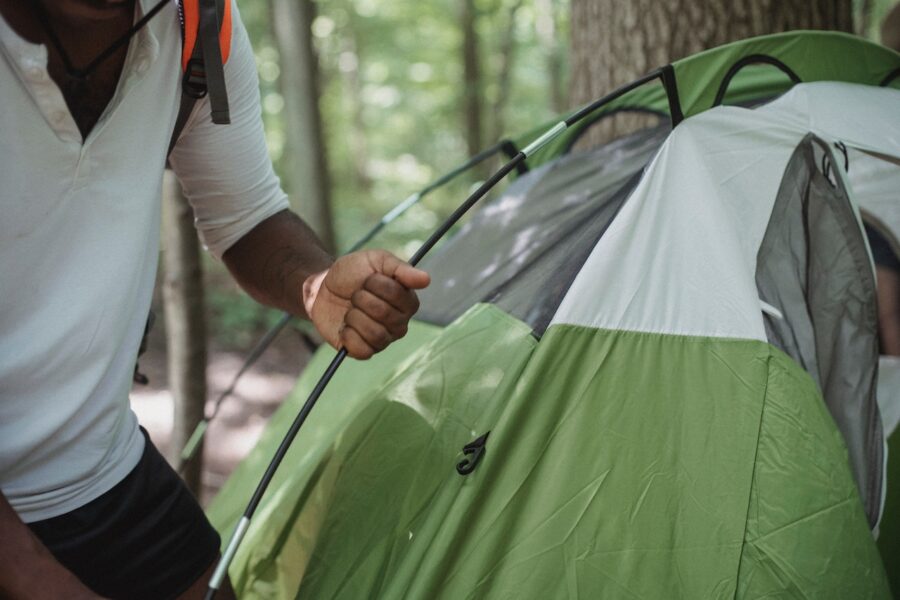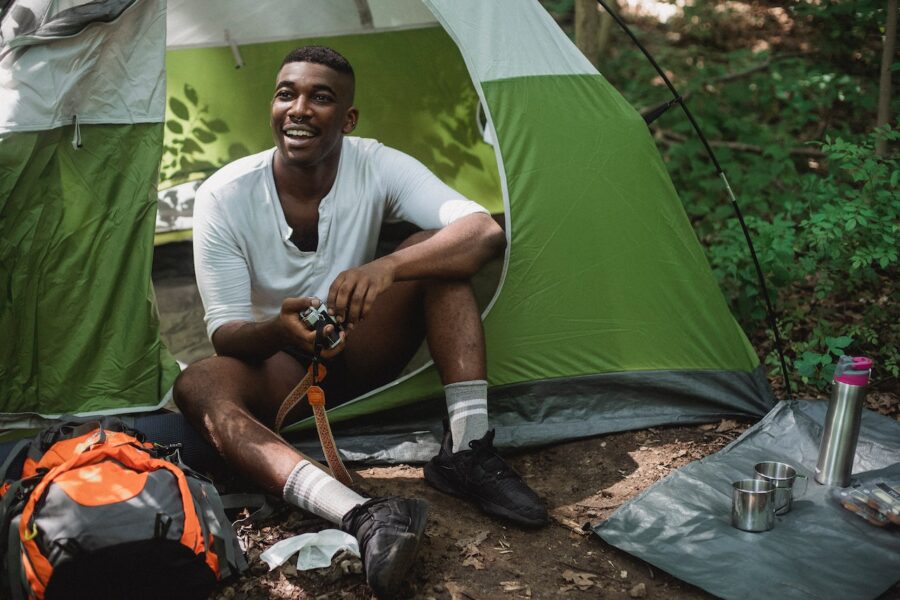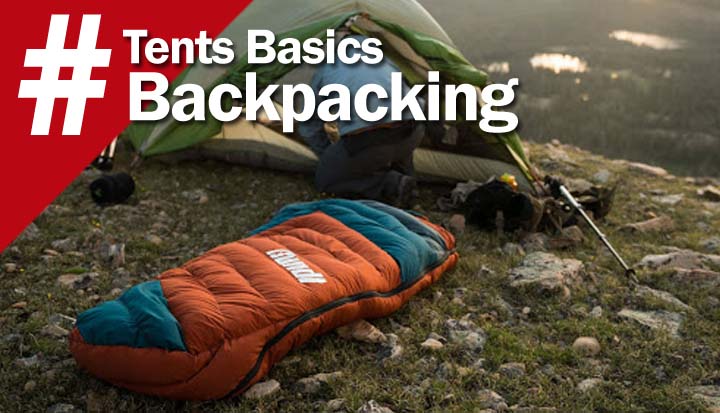What is backpacking and backpacking tents? It’s a tent or some form of shelter that you carry with you while on a backpacking trip. Bringing some sort of tent or shelter with you is important to protect you from the weather.
Backpacking is a form of low-cost, independent travel, often staying in inexpensive lodgings and carrying all necessary possessions in a backpack.
Source: Wikipedia
Greetings, fellow adventurers and nature enthusiasts! In a world saturated with screens and schedules, the allure of the great outdoors beckons like a siren’s call. The wild whispers promises of freedom, discovery, and rejuvenation. And what better way to answer that call than with a trusty companion by your side – the versatile and ever-reliable backpacking tent. Let’s delve into the captivating world of backpacking tents, discovering their essence, designs, features, and how they’re reshaping the way we explore the wilderness in 2023.

1. The Essence of Backpacking Tents
A Shield against Nature’s Whims
Picture this: you’re in the heart of nature’s bounty, surrounded by lush woodlands, towering peaks, and rolling meadows. While the allure is undeniable, so is the unpredictability of the elements. Enter the backpacking tent – more than just a shelter, it’s a sanctuary against nature’s whims. Imagine raindrops tapping gently on its surface and the wind playing with leaves nearby, while you remain snug and secure within. It’s your steadfast companion, offering comfort and protection against the unknown.
2. The Spirit of Self-Reliance
Celebrating the Art of Minimalism
In a world of excess, backpacking embodies the spirit of self-sufficiency and simplicity. Unlike traditional camping with its bulky gear and elaborate setups, backpacking invites us to embrace the art of minimalism. And at the heart of this movement lies the lightweight backpacking tent – a symbol of your ability to immerse yourself in the wilderness with only the essentials. It’s about shedding the unnecessary, connecting with nature, and crafting your own path.
3. Exploring the Architecture of Backpacking Tents
Compactness and Mobility
The essence of backpacking hinges on mobility, and backpacking tents are the epitome of this philosophy. Modern tent designs prioritize compactness and portability, allowing you to venture further with ease. Manufacturers are embracing advanced materials and innovative construction methods to create tents that are not only lightweight but also incredibly space-efficient when packed. This evolution empowers you to carry more gear while keeping your load manageable, making those long hikes all the more enjoyable.
Versatility in Design
Just as no two adventures are the same, the same holds true for backpacking tents. The market showcases a diverse array of designs tailored to various terrains and weather conditions. From classic dome tents to streamlined tunnel tents and versatile hybrids, there’s an option for every preference. This variety ensures that you can find the perfect tent to match the unique demands of your journey.
4. Choosing the Perfect Backpacking Tent
Weight Considerations
Embracing the ultralight movement, backpacking tents have shed excess weight in recent years. Statistics reveal that the average weight of these tents has decreased by around 20% over the last half-decade. Brands are embracing innovative materials and shedding unnecessary features to create tents that weigh only a few pounds. This shift is redefining backpacking, enabling enthusiasts to explore more terrain with less physical strain.

Capacity and Group Adventures
The landscape of group backpacking is evolving, and so are tent designs. No longer limited to solo or duo trips, larger groups are embracing the wild together. Manufacturers have responded by crafting tents that comfortably house more occupants without sacrificing weight and portability. Versatility is now the name of the game, catering to both solo and group explorers.
Comfort and Tent Features
Modern backpacking tents redefine comfort. They go beyond providing mere shelter; they’re designed with ergonomics in mind. Increased headroom, well-placed internal space, integrated storage solutions, gear lofts, and pockets are standard features. These elements create a well-organized living space within your tent, ensuring that your home away from home is as convenient as it is comfortable.
5. Exploring Key Attributes
Multiple Entrances: Convenience Amplified
The convenience of multiple entrances is gaining traction. No more disturbing tent mates during midnight exits. This feature is especially valuable for group trips, allowing each occupant to move in and out without disturbing others.
Optimal Ventilation
Ventilation is no longer a luxury but a necessity. Modern tents incorporate strategic mesh panels that ensure proper airflow, preventing condensation buildup and maintaining a comfortable interior. These innovative ventilation systems strike a balance between airflow and insect prevention.
Anchoring Stability
Stability is paramount, especially in challenging weather conditions. Tents now feature multiple attachment points for guy lines, securing your tent even in gusty winds. Reflective materials woven into these lines provide an extra layer of safety in low-light conditions.
Robust Zippers for Seamless Access
Zippers are unsung heroes in backpacking tents. Recent trends point toward larger, more durable zippers that can withstand wear and tear. Thoughtful placement minimizes snagging, while reinforced designs ensure longevity, preventing frustrating glitches during critical moments.
6. Decoding Tent Varieties
Double Wall Tents: The Sanctuary of Comfort
Double wall tents continue to be favorites among backpackers seeking comfort and versatility. The mesh body ensures ample ventilation and insect protection, while the rainfly offers weather resistance. This category is evolving with improved materials, streamlined designs, and enhanced convenience features.
Single Wall Tents: Lightweight Exploration
For those valuing minimalism, single wall tents are gaining traction. The trend is all about using advanced waterproof materials that balance breathability with protection. While some comfort might be sacrificed, single wall tents offer an unparalleled lightweight solution for dedicated backpackers aiming for maximum efficiency.
7. Elevating Comfort with Vestibules
Storage and More
Vestibules have transformed from simple extensions to integral storage spaces. Backpackers now seek tents with well-designed vestibules that shelter gear, muddy footwear, and even cooking setups. This trend enhances tent organization, keeping your interior tidy and elevating overall comfort.
Matching Seasons: Adapting to Weather Extremes
Trends reveal that backpackers are aligning their tent choices with their intended seasons of exploration. The popularity of 4-season tents is on the rise, with more adventurers venturing into winter landscapes. These tents are engineered to withstand snow loads, strong winds, and freezing temperatures, guaranteeing safety and comfort even in the harshest environments.
Accommodating Group Dynamics
As group dynamics evolve, so do tent preferences. Larger tents that comfortably house more occupants are gaining traction. This trend fosters shared experiences while minimizing the need for multiple tents.
Tailoring for Comfort
Backpacking tent features are no longer indulgent extras; they are essential for a comfortable journey. The latest trend involves tents with built-in gear storage solutions, internal organization pockets, and integrated lighting options. These features transform the tent into a home away from home, where everything has its place.
9. Investing in Durability
Sturdy Zippers: Gateways to Longevity
The importance of zippers in backpacking tents cannot be overstated. Recent statistics emphasize a preference for tents equipped with durable, sizable zippers. Reinforced designs and corrosion-resistant materials extend the lifespan of zippers, ensuring smooth operation even after extensive use.
Fortifying Structure against the Elements
In the face of unpredictable weather, sturdiness is non-negotiable. Backpackers are investing in tents with reinforced structures, including robust pole systems and strategic attachment points. This proactive approach to durability guarantees the tent’s resilience, ensuring it stands strong against the elements.
10. Balancing Weight and Efficiency
Solo Pursuits: Embracing Minimalism
The allure of solo backpacking is prompting enthusiasts to adopt ultralight gear. Backpackers are drawn to tents that strike the delicate balance between weight and functionality. Embracing minimalist setups means shedding the unnecessary while safeguarding essential comfort and protection.
For those embarking on group backpacking, weight distribution is a vital consideration. Statistics indicate that tents designed for groups prioritize an even allocation of weight. This approach ensures that each backpacker can manage their load, resulting in a more enjoyable and less strenuous journey for everyone.
11. Cracking the Price Code
Material Quality and Craftsmanship
The value of material quality has gained prominence. Backpackers are willing to invest in tents crafted from premium materials, promising enhanced durability and performance. This approach transforms the tent into a long-term investment, capable of withstanding numerous adventures.
You should check out Top 5 Best Backpacking Tent under 100 dollars (2023) and 3 Best hiking backpack under 100 – Affordable & Cheap
The Influence of Brand and Marketing
While brand loyalty and marketing still play a role in purchasing decisions, backpackers are becoming more discerning. They focus on the actual features and specifications offered by a tent, prioritizing value over brand reputation. This trend fosters an informed decision-making process centered on worth.
Balancing Cost and Needs
The ultimate goal is to find a tent that aligns with your specific needs without unnecessary extras. Budget-conscious backpackers are opting for tents that meet their requirements, avoiding overpriced models with features they won’t fully utilize. This trend champions value for money and a tailored backpacking journey.
12. Selecting the Ultimate Tent: A Personalized Choice
Synthesizing Factors: The Definitive Choice
The process of choosing the right backpacking tent is a delicate balance of multiple considerations. Recent trends reveal that backpackers approach this decision holistically, taking into account everything from anticipated weather to terrain ahead. This thoughtful approach ensures that the selected tent becomes an extension of their adventure.

Adapting to Evolving Needs
Just as backpacking is a journey that evolves, so do the needs of backpackers. Recent statistics highlight that many enthusiasts own multiple tents, each suited for distinct seasons and terrains. This trend underscores the versatility of backpackers and their dedication to finding the perfect gear for every expedition.
Beyond the Statistics: Embracing Adventure’s Spirit
Beyond data and technicalities, the essence of backpacking tents lies in the spirit of adventure they encapsulate. These tents embody the passion, excitement, and unwavering human spirit that drive us to explore the uncharted.
13. Why Choosing the Right Backpacking Tent Matters
Selecting the right backpacking tent is more than just a decision; it’s an investment in your overall outdoor experience. A well-chosen tent offers a cozy retreat after a day of hiking, a shield against unexpected weather changes, and a comfortable space to rest and rejuvenate. On the other hand, an ill-suited tent can lead to discomfort, insufficient protection, and a less-than-ideal adventure. So, let’s dive into the key features you should consider when looking for your ideal backpacking tent.
14. Key Features to Consider

Weight and Portability
When venturing into the wilderness, every ounce counts. Opt for a lightweight and compact tent that won’t weigh you down during your hikes. Modern backpacking tents are designed with lightweight materials and innovative construction techniques, ensuring you can carry your shelter effortlessly while still having enough space for other essential gear.
Durability and Weather Resistance
Nature can be unpredictable, so your tent should be built to withstand a range of weather conditions. Look for tents with sturdy materials, reinforced seams, and a reliable rainfly to keep you dry even during unexpected downpours. Additionally, choose a tent with proper ventilation to minimize condensation buildup and ensure comfort.
Check out Your Ultimate Guide to Camping: Tents, Backpacks, and More!
Tent Capacity and Size
Consider how many people will be sharing the tent. Backpacking tents typically come in various sizes, accommodating anywhere from one to four occupants. Keep in mind that while a larger tent offers more space, it also adds to the overall weight. Strike a balance between comfort and portability based on your group size.
Setup and Ease of Use
After a long day of hiking, the last thing you want is a complicated tent setup process. Opt for a tent that is easy to assemble, with color-coded poles and intuitive designs. Freestanding tents are particularly convenient, as they can be set up without relying on stakes and guylines.
15. Types of Backpacking Tents

Single-Wall Tents
Single-wall tents combine shelter and rain protection in one layer. They are lightweight and suitable for fair weather conditions. However, they may experience more condensation buildup compared to double-wall tents.
Double-Wall Tents
Double-wall tents consist of an inner tent with mesh for ventilation and an outer rainfly for protection. They offer better breathability and are suitable for various weather conditions. While slightly heavier, their versatility makes them a popular choice among backpackers.
Three-Season Tents
Three-season tents are designed for spring, summer, and fall adventures. They prioritize ventilation and lightweight construction. While they can handle light rain and wind, they might not withstand heavy snow loads or extreme winter conditions.
Four-Season Tents
Four-season tents are built to handle harsh winter conditions, including snow, wind, and cold temperatures. They feature robust materials, steep sidewalls to shed snow, and minimal mesh to retain warmth. Keep in mind that they tend to be heavier and may be overkill for milder seasons.
16. Tips for Setting Up Your Backpacking Tent
Setting up your tent correctly is crucial for a comfortable and safe camping experience. Here are some tips to ensure a smooth setup process:
- Practice at Home: Familiarize yourself with the setup process in your backyard before heading out on your adventure.
- Choose the Right Site: Look for a flat and level spot to pitch your tent. Clear away any rocks or debris that could puncture the floor.
- Stake Down the Corners: Start by staking down the corners of your tent to keep it in place.
- Assemble the Poles: Follow the manufacturer’s instructions to assemble the tent poles and attach them to the tent body.
- Attach the Rainfly: If your tent has a rainfly, attach it for extra weather protection.
- Tension the Guylines: Use guylines to secure your tent and improve stability in windy conditions.
17. Caring for Your Tent: Maintenance and Storage
Proper care and maintenance can extend the lifespan of your backpacking tent. After each trip, make sure to:
- Dry It Out: Dry your tent thoroughly before storing it to prevent mold and mildew growth.
- Clean It Gently: Use a mild soap and water solution to clean the tent. Avoid harsh chemicals that could damage the fabric’s waterproof coating.
- Store It Loosely: Store your tent loosely in a cool, dry place. Avoid compressing it for extended periods, as this can weaken the fabric and seams.
18. Choosing the Right Tent for Your Adventure
Solo Backpacking
If you’re a solo adventurer, a one-person tent offers the perfect balance between space and weight. Look for a tent that’s easy to set up on your own and provides enough room for you and your gear.
Group Expeditions
For group backpacking trips, opt for a larger tent that can accommodate multiple people comfortably. Consider a tent with separate sleeping areas to enhance privacy.
Four-Season Adventures
If you’re planning to explore winter landscapes or high-altitude terrain, a four-season tent is essential. These tents are designed to withstand extreme weather conditions, including heavy snow and strong winds.
19. In Conclusion: Embracing Your Haven
Finding Tranquility in the Wild
Amidst the chaos of modern life, the call of the wild remains unwavering. Backpacking tents, with their evolving designs, innovative features, and adaptability, epitomize the spirit of adventure. As you traverse diverse landscapes and immerse yourself in nature’s wonders, your backpacking tent stands as a testament to your bravery, curiosity, and affinity for the untamed world.
20. Frequently Asked Questions:
Your Backpacking Tents Queries Answered
Q: Are 4-season tents appropriate for all backpacking scenarios? A: While 4-season tents excel in robust weather protection, they might be excessive for milder conditions. Consider anticipated weather and terrain before making your decision.
Q: What role do vestibules play in backpacking tents? A: Vestibules offer extra storage space beyond the main tent, keeping your gear organized and dry.
Q: How crucial are lightweight materials in backpacking tents? A: Lightweight materials reduce overall pack weight, enhancing mobility during your expedition.
Q: Can a single wall tent be used in all seasons? A: Single wall tents are suitable for fair weather and lightweight adventures. However, they might not offer the same level of comfort as double wall tents in extreme conditions.
Q: How can I strike a balance between budget and quality when choosing a backpacking tent? A: Prioritize essential features aligned with your adventure goals. Invest in durable materials and longevity, but avoid overpaying for unnecessary features.
Embrace the wilderness with the perfect backpacking tent that aligns with your spirit of adventure. With evolving designs, innovative features, and a personalized touch, your backpacking tent becomes more than a shelter – it’s a doorway to exploration, self-discovery, and unforgettable experiences.

